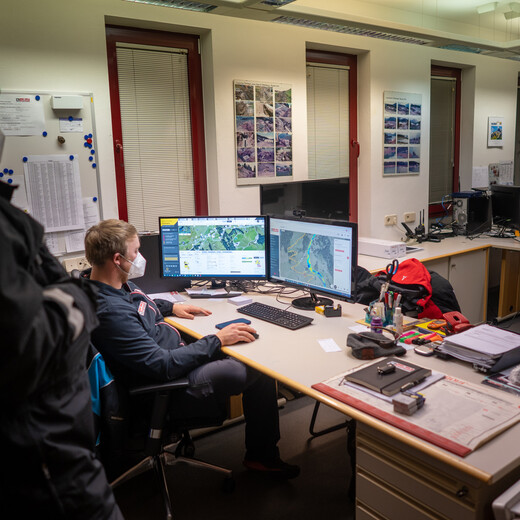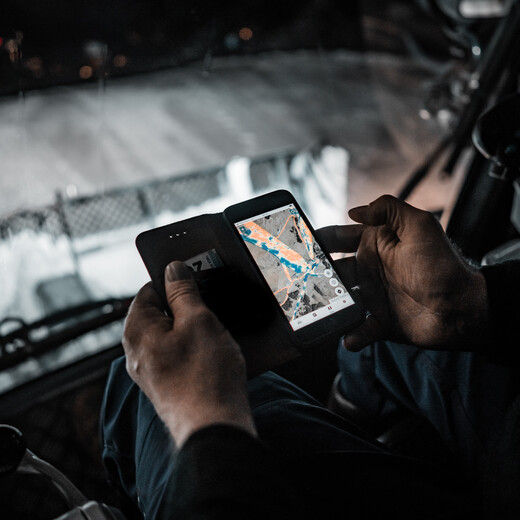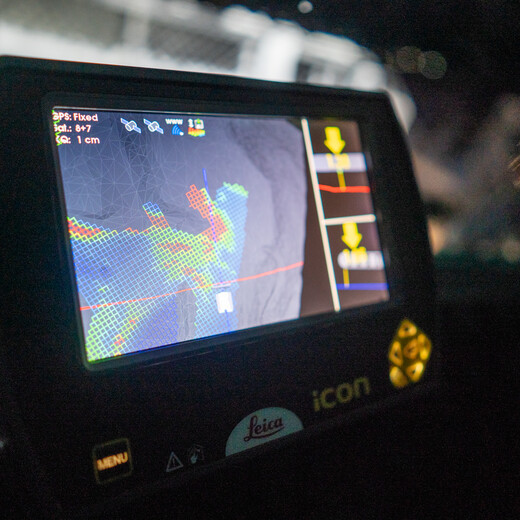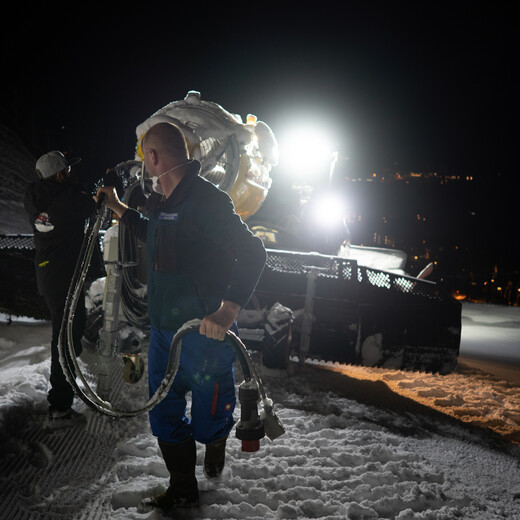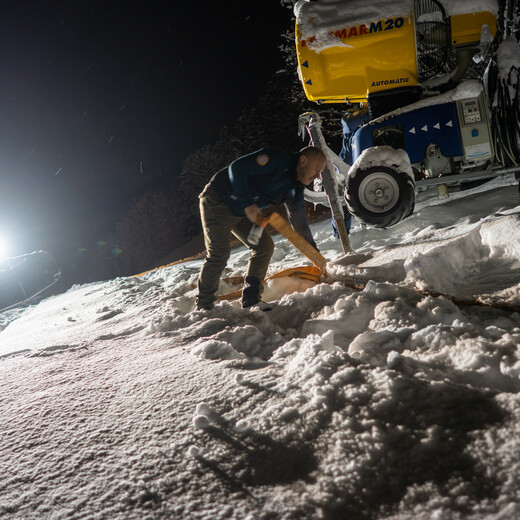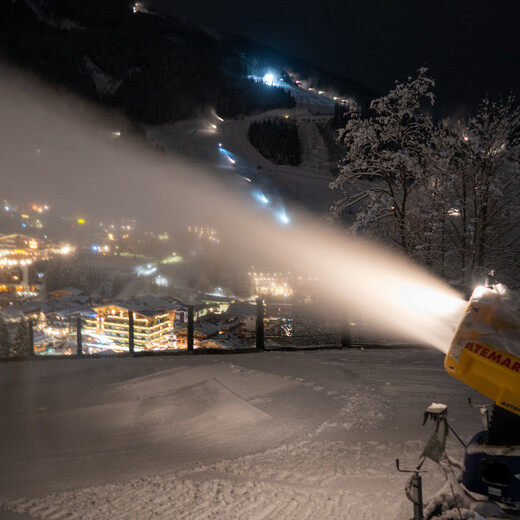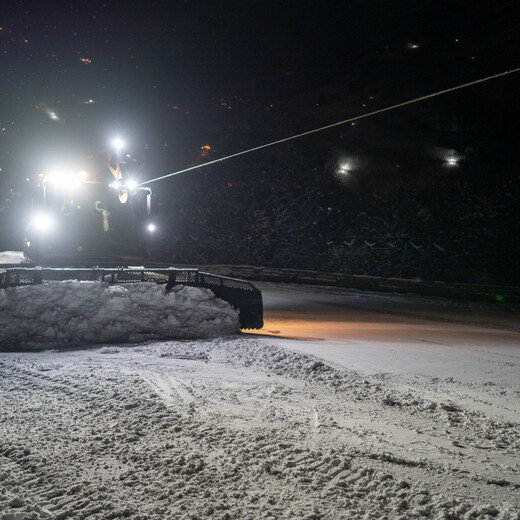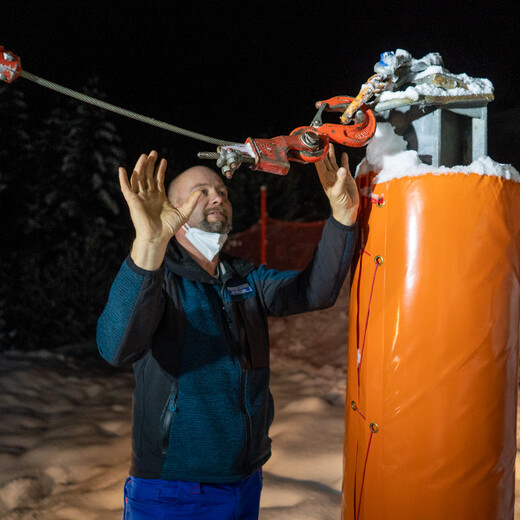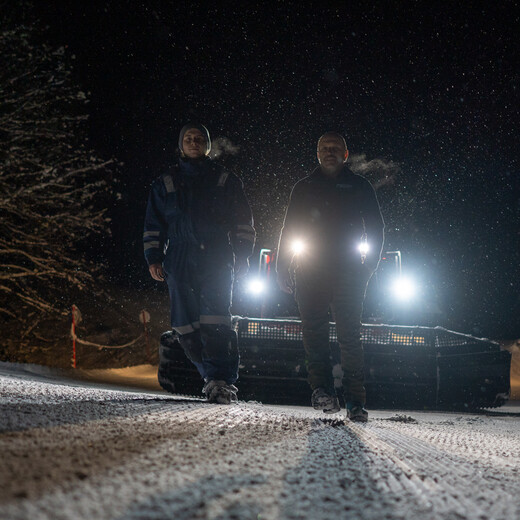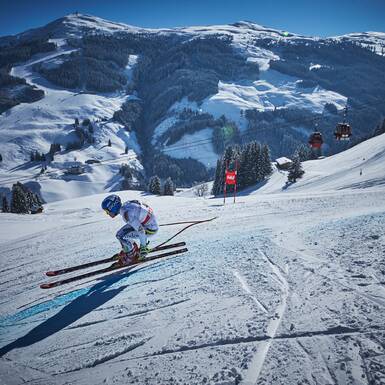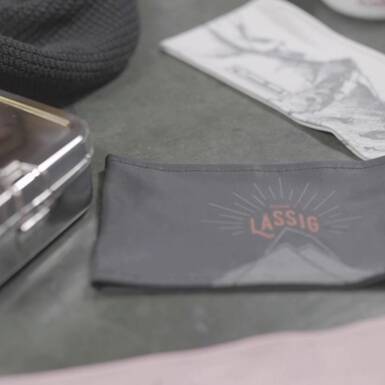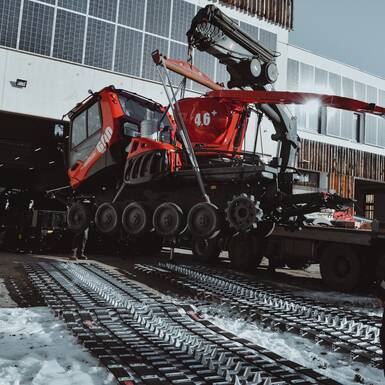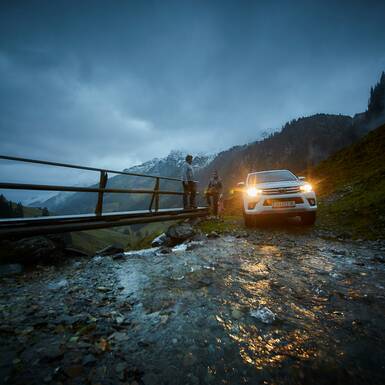- Backstage
A Nightshift for the perfect Slope
It’s midnight and the sky in Saalbach Hnterglemm is illuminated by countless, bright stars. There are tiny lights everywhere – some are moving, others are standing still. One of them seems to be slowly climbing into the stratosphere almost vertically. That path is an illusion though, it must be. Like on most clear and moonless nights, the steeps flanks and tall peaks of the surrounding mountains have seemingly melted into the dark sky, becoming virtually indistinguishable from one another. Looking down into the valley, the opposite is the case. 500 meters below us, two towns glow in the warm, yellow hue of thousands of lights. We wonder what might be happening down there, but we can only speculate. We’re far away from everything, surrounded by deep darkness, peaceful quiet, and the smell of winter.
We’re about halfway up on the Reiterkogel in Saalbach Hinterglemm. Until 5pm, skiers and snowboarders painted their lines in the snow up here while the piste maintenance crew was fast asleep. They start their work when most of us head in for the evening, after all. Once the slopes have emptied and the gondola’s have been parked in their stations for the night, the slope-grooming and snowmaking crews meet with Deputy Operations Manager Christoph Kendler to discuss the night’s work.
“We survey our terrain in summer, either by hand or with a drone. That way, we have an accurate and up-to-date three-dimensional model of the mountain that allows us to precisely plan our operation”, explains Christopher. Later that night, I’ll learn that the piste machines (also called groomers) use GNSS devices to constantly measure snow height and provide up-to-date data for the models. This way, the entire snowmaking and maintenance crew always knows where there’s enough snow and where more might be needed.
Now it’s time for me to head up the mountain. The higher we go, the colder, the quieter and the more beautiful it gets. We reach the basecamp of the piste machine drivers and snowmakers after about 15 minutes, and I jump off the quad and into the warm cabin of Roland Fritzenwanker’s groomer. He’s been driving a groomer for 18 years and tells me that he still loves his job. I can hear the excitement in his voice when he talks about the huge machine that he gets to drive around the mountain every winter to etch that fresh corduroy into the slopes for the following morning.
“We work four nights in a row, then get one night off. That’s our shift rotation. We start work at 5pm and, depending on the condition of the slopes, we finish the first part of our work between 10pm and midnight. By then, the slopes should be all smoothed out.”, explains Roland as I closely monitor the colorful screen in front of him with ill-concealed interest. “This is a GNSS device. It measures snow height and sends the data to the rest of the team via satellite so that we always know where we might have to create more snow.” So, this is how the crew gets the data for their operations planning, but there’s more to it.
The Art of making Snow
The accurate measurement of snow heights dramatically increases efficiency and thereby saves costly machine hours and valuable resources like the water and energy needed for snowmaking. Amongst the onslaught of information, I also learned that the term artificial snow is technically inaccurate. The process of how the snow is made might seem like an art to me, but there’s not much artificial about the man-made snow at all, actually. Virtually all the man-made snow in the Skicircus Saalbach Hinterglemm Leogang Fieberbrunn is being created without the use of any chemicals. Additionally, all water that is used for snowmaking is sourced through natural springs, rainwater and snowmelt. Technically speaking, the water also doesn’t really get ‘used’, as an intelligent water cycle makes sure that the spring’s snowmelt and summer’s rain fill up the snowmaking water reservoirs for the next winter.
As I’m being told that night, these reservoirs also play in an important role in flood prevention (something that is crucial for all mountain communities) as they can store extreme amounts of water after heavy storms which can then be slowly drained in a controlled manner.
But let’s get back to Roland’s nightshift. What happens if it snows past midnight? “We always have an eye on the weather report. If it snows, we get back into the groomers at 4am and push the freshly fallen snow back off the slopes so that everything is perfectly groomed when we open the lifts.”
By now, Roland has finished preparing the mellow slope next to the mid-station and I want to know how it looks and feels like to drive these huge machines on some steeper slopes. After a quick call on the radio, I’m picked up by Wolfgang Kendler and we head to some more serious terrain.
Warning! Mortal Danger! Or why the slopes are closed at night
Wolfgang’s groomer is the most modern one on the mountain and is equipped with a winch so that the huge machine can be secured in steep terrain. Wolfang secures the thick cable to a large metal pole and asks a colleague to secure the area. Unfortunately, not everybody respects the slope closures which necessitates the additional security as a skier or snowboarder hitting the cable can have deadly consequences. “The problem is that the cable can bury itself in the snow and become invisible when we drive over a crest. Continuing our work far below the crest, we obviously move around the slope a lot which puts tension on the cable. Once the tension becomes too great, it suddenly releases and the heavy cable snaps out of the snow like a gigantic whip which, as you can imagine, has serious consequences for anybody standing in the way”, explains Roland. “Now factor in that the cable might be at head-height in between crests, is barely visible at night and that the groomer might be a long, long distance down the hill and it therefore might not be obvious that we’re even working on the slope, and you can see how incredibly dangerous this can be. So, if you don’t want to risk your life, it might be smart to adhere to slope closures.”
We had back to the garage to fuel up. Despite the freezing temperatures, we don’t have to warm up, though, as the cabin of the 14-ton machine is nice and warm, almost cozy even. We hear voices from the room next to us and I’m intrigued. Listening in, I realize that it’s Andreas Altenberger, who drove me up the mountain earlier, and his snowmaking crew. They’re planning the relocation of one of the mobile snowmaking machines which requires the help of one of the large groomers.
While I was sitting in a groomer with Wolfgang and Roland, Andreas and his brother Anton got the 105 snow canons and snow lances going. Now it’s time to top up the thinner layers of snow with mobile snow making machines. In order to position them, the brothers hook them up to one of the groomers which then drags them to the right spot. Once they’re in position, the water hoses need to be unrolled and hooked up. At the end of the shift, these hoses need to be disconnected and drained again. “Water has the awkward habit of freezing at cold temperatures.”, Andi jokes in response to my amateurish questions.
We wait until the machine has warmed up and begins to run to make sure that Andi has picked the right angle before climbing onto a fast skidoo and to head back to the base at the mid station of the Reiterkogel. Once there, he checks the computer screen for a status update and readjusts the angles as well as the snow quality of the machines with a few clicks of his mouse.
This is where the cold but adrenaline-fueled part of the night begins. Andi knows exactly how to get from A to B as quickly as possible with his skidoo and we race across the entire mountain to check on the snow machines he and his brother are responsible for before heading back to perform small adjustments on the computer screen. My face is frozen and my teeth are chattering after the first trip. Andi doesn’t seem to be fazed by the cold at all. The freezing temperature might be uncomfortable, but the brothers are in good spirits, and so am I. The adrenaline in my veins from the rapid skidoo ride and the freezing wind on my face have gotten rid of any hint of tiredness I might have had at this late hour. “Riding a skidoo just never gets boring” I can see how the brothers could be right about that.
My shift ends at 1AM but Andi’s day – or night – of work is far from over. I step outside once more and gaze at the surrounding mountains. I see dots of light all around the valley, but I already know that I’ll never see them in the same way again. A slow-moving light tells me that a groomer is hard at work to make sure the next day’s skiing will be as epic as the last. I spot a fast-moving light and have to smile as I know someone out there is enjoying his work riding a skidoo while the static lights make sure that there is a good base for the slopes. I tilt my head back and look at the bright stars in the clear night sky. They tell me that tomorrow will be a bluebird day.

